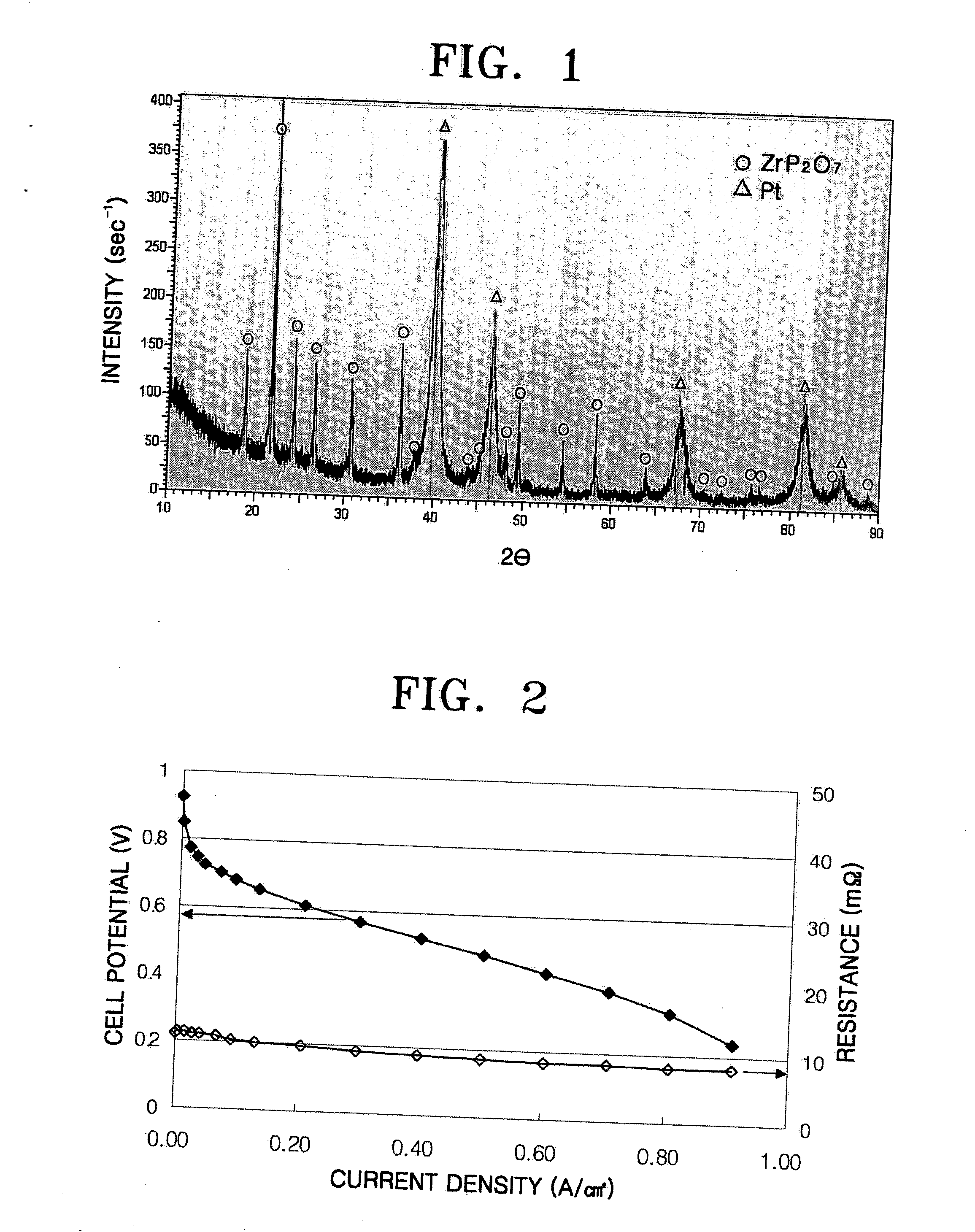Fuel cell electrode containing metal phosphate and fuel cell using the same
- Summary
- Abstract
- Description
- Claims
- Application Information
AI Technical Summary
Benefits of technology
Problems solved by technology
Method used
Image
Examples
example 1
[0059] 1.0 g of a carbon supported Pt (Pt / C) catalyst (50% Pt) was dissolved in 25 ml of a ZrOCl2 solution (0.1 M), and then aqueous ammonia was added dropwise while stirring the solution and measuring the pH. When the pH was equal to 1, the addition of aqueous ammonia was stopped and the solution was stirred at room temperature for 2 hours. The mixed liquid was filtered with a filter paper to separate the supported catalyst-metal oxide composite. The separated supported catalyst-metal oxide composite was washed twice with water. Next, the supported catalyst-metal oxide composite was dried at 200° C. for 2 hours and then heat treated at 550° C. for 1 hour. The resultant was mixed with 1.0 g of a 105% aqueous phosphoric acid solution and 7 g of ethanol at 140° C. for 1 hour. The mixture was stirred at 180° C. for 1 hour.
[0060] The mixture was heat treated in a furnace at 600° C. for 1 hour.
[0061] The solid powder obtained by the heat treatment was subjected to a XRD analysis and th...
examples 2 to 6
[0062] 1.0 g of a carbon supported Pt (Pt / C) catalyst (50% Pt) was dissolved in 22 ml of a ZrOCl2 solution (0.05 M), and then aqueous ammonia was added dropwise while stirring the solution and measuring the pH. When the pH was equal to 1, the addition of aqueous ammonia was stopped and the solution was stirred at room temperature for 30 minutes. The mixed liquid was filtered with a filter paper to separate a supported catalyst-metal oxide composite. The separated supported catalyst-metal oxide composite was washed twice with water. Next, the supported catalyst-metal oxide composite was dried at 200° C. for 1 hour. The resultant was mixed with 1.0 g of a 105% aqueous phosphoric acid solution and 7 g of ethanol. The mixture was stirred at 180° C. for 1 hour. The amount of the aqueous phosphoric acid solution was adjusted such that the weight ratio of phosphoric acid to the supported Pt catalyst set forth in Table 1 is attained.
[0063] The mixed liquid was heat treated in a furnace at ...
example 7
[0067] An electrode was prepared in the same manner as in Examples 2 to 6, except that the weight ratio of phosphoric acid / Pt was 1.6 and the amount of the binder was 4% by weight. A membrane electrode assembly (MEA) was formed using the obtained electrode and a PBI membrane. A fuel cell was formed using the MEA. The performance of the fuel cell was measured while supplying hydrogen and air to a cathode and an anode at 150° C. The results are illustrated in FIG. 2.
[0068] As can be seen from FIG. 2, the fuel cell exhibited a potential of about 0.61 V at a current density of 0.2 A / cm2.
PUM
 Login to View More
Login to View More Abstract
Description
Claims
Application Information
 Login to View More
Login to View More - Generate Ideas
- Intellectual Property
- Life Sciences
- Materials
- Tech Scout
- Unparalleled Data Quality
- Higher Quality Content
- 60% Fewer Hallucinations
Browse by: Latest US Patents, China's latest patents, Technical Efficacy Thesaurus, Application Domain, Technology Topic, Popular Technical Reports.
© 2025 PatSnap. All rights reserved.Legal|Privacy policy|Modern Slavery Act Transparency Statement|Sitemap|About US| Contact US: help@patsnap.com

